IELTS and TOEFL essay rubrics
As teachers, it is helpful to use IELTS and TOEFL essay rubrics to guide our students to get top scores on their independent essays. However, sometimes the language in the rubrics can be unclear and the jargon may confuse us and more specifically, baffle our students. Therefore, in this post, I am going to give some examples of what the different sections of the rubrics mean and what you can do to help your students understand the wording. Finally, I’ll give you some tips to help your students build crucial skills in the area of writing.
This blog post was inspired by a training that I participated in by Michael Goodine, founder of TOEFL Resources hosted by ETS TOEFL Global and you can sign-up for future trainings at this link. Also, if you want to see the complete list of ETS webinars, you can find them here. If you would like to learn about the family of TOEFL assessments that are available, this is a great article.
Essentially, I’ll be decoding some tricky parts of the IELTS and TOEFL independent essay rubrics and I’ll give you some pedagogical strategies to use with your students to help them strengthen their writing skills. In addition, Michael also gives some great tips for online TOEFL teachers in this article.
1.Write about the topic in the question
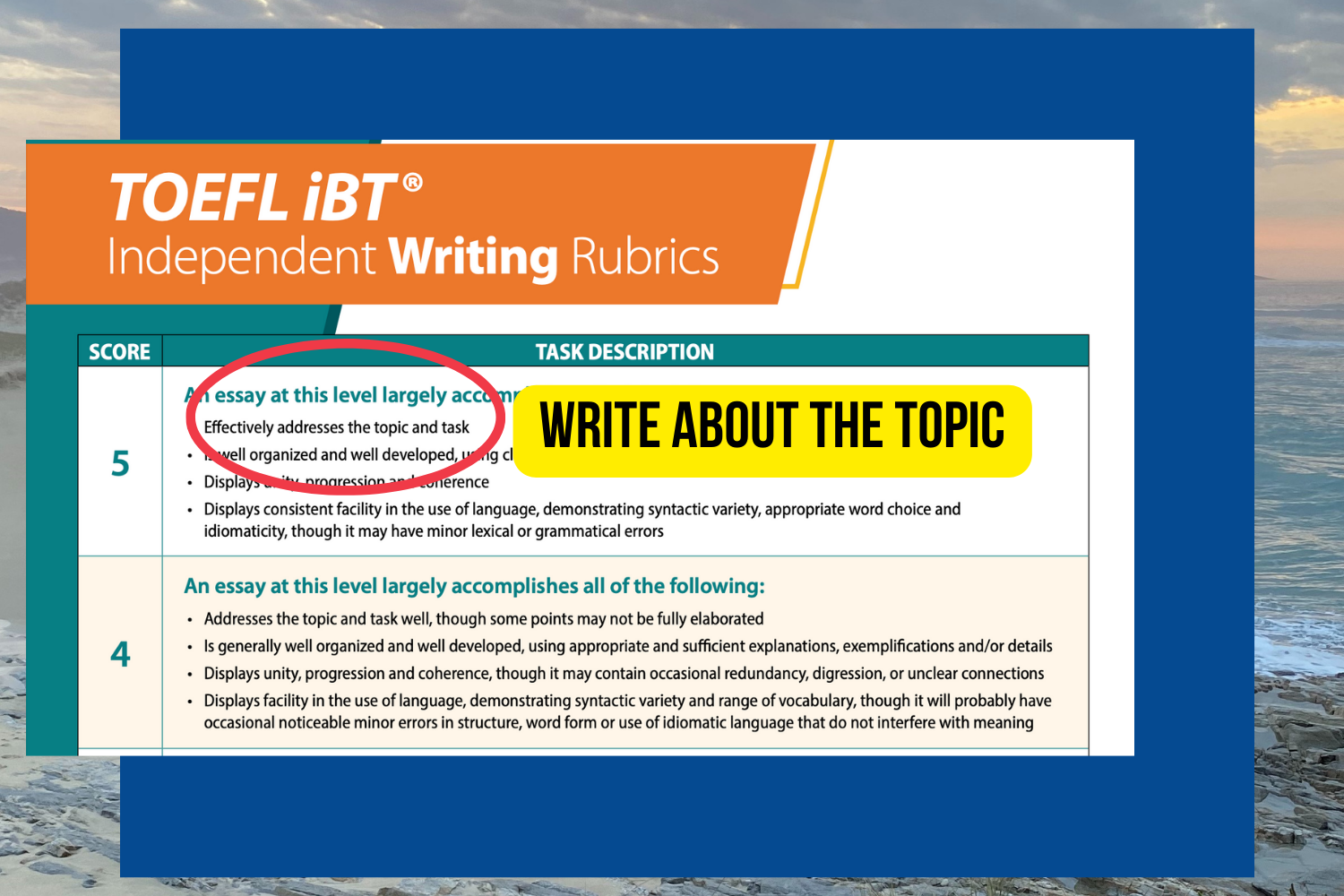
This point on both rubrics speaks for itself. However, some students still try to answer a different question or slightly tweak the response to fit a topic that is of more interest to them. It is a big mistake if students don’t focus on the topic at hand because it deserves their full attention.
An example of a recent essay topic a student of mine had on the TOEFL was: Do you agree or disagree with the following statement: The fast development of our cities has a positive effect on the development of society. So, one mistake a student might make would be to not fully answer the question and talk only about the fast development of cities and omit a discussion of its influence on society. Both the IELTS and the TOEFL rubrics focus on the importance of developing ideas around the topic in the essay question. The IELTS rubric emphasizes the importance of fully supported ideas, while the TOEFL rubric states well-developed ideas.
Both TOEFL and IELTS teachers emphasize the importance of exceeding the minimum word count in order to provide a more in-depth answer.
Moreover, one of the differences I discovered from IELTS experts on LinkedIn is that the IELTS essay examples should be more general and less personal, while personal examples are encouraged in the TOEFL essay. Nevertheless, Michael Goodine mentioned in the webinar that although personal examples are recommended in the body paragraphs in the TOEFL independent essays, more general arguments in the body paragraphs can also be supported broad examples from society without fear of getting a lower score.
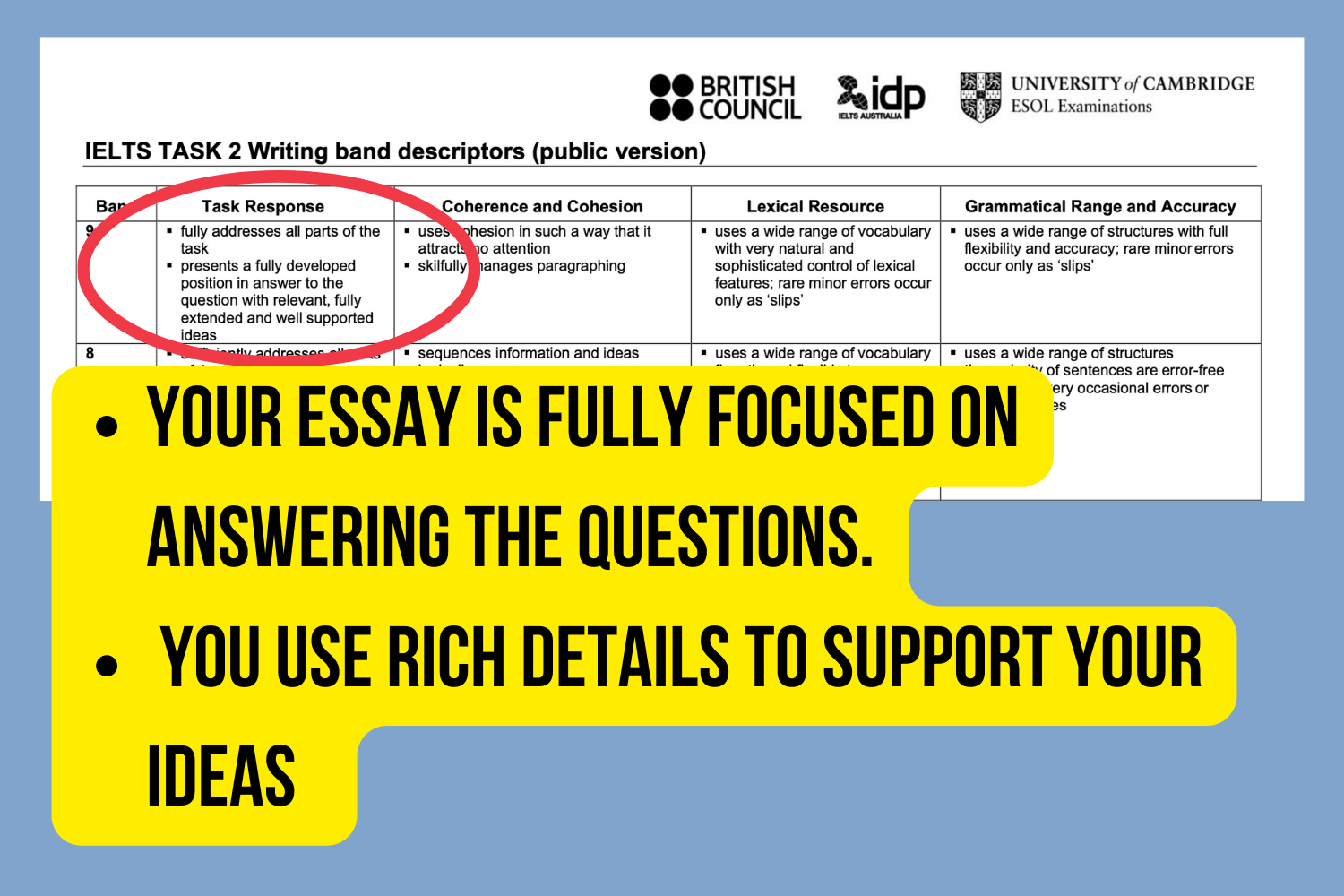
1. Organize Your Essay Using Transitional Language
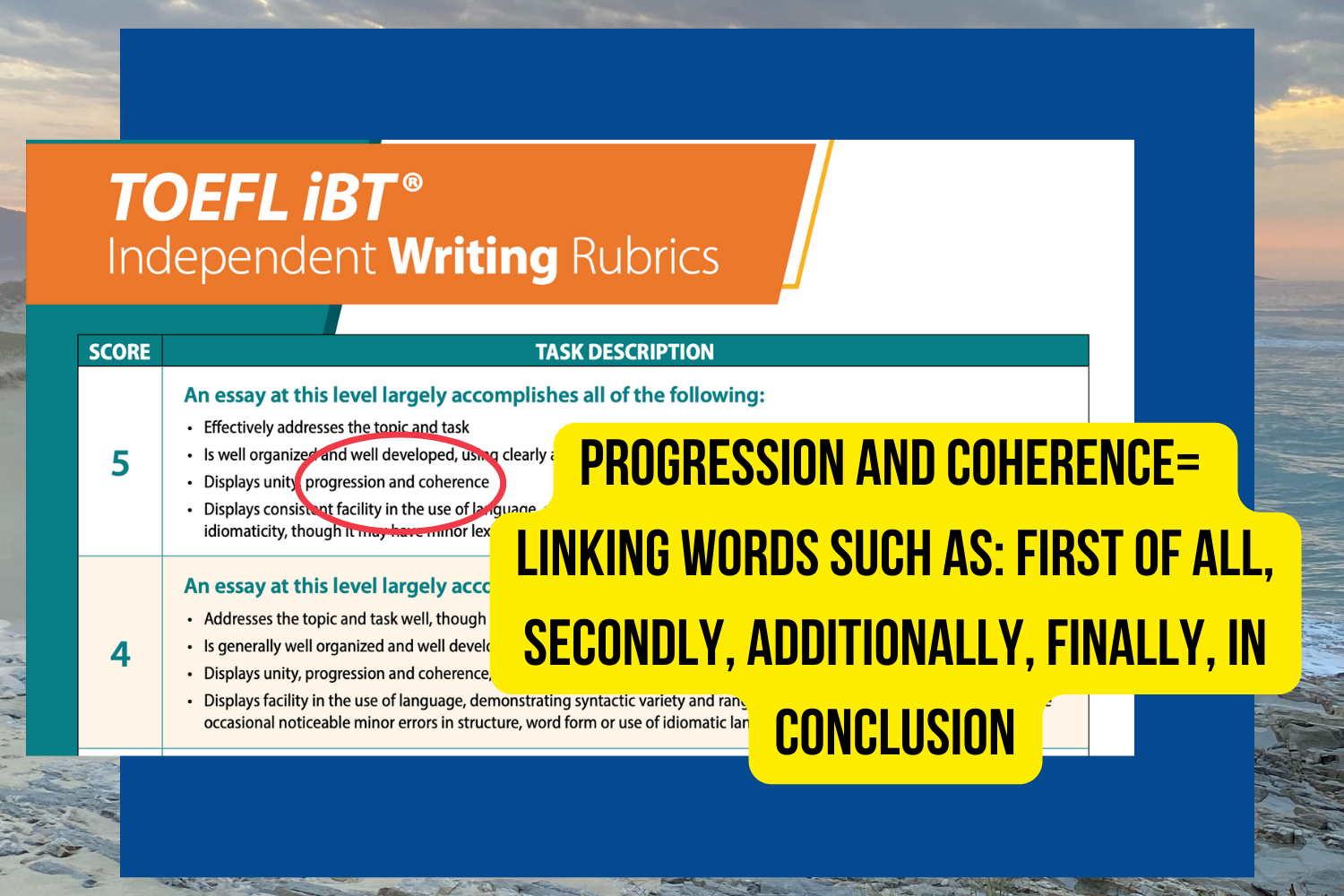
Both rubrics point out the importance of organizing the essay. In the IELTS rubric, the idea of paragraphing is mentioned, which points to the idea of using a quintessential paragraph structure with an introduction, body paragraphs, and a conclusion. The TOEFL rubric doesn’t state paragraphs specifically, but does mention the idea of unity, which is quite vague in comparison to the more specific language in the IELTS rubric.
Therefore, the idea of progression and coherence could be interpreted as using linking words and transitional language from one paragraph to the next and even within body paragraphs. Even though the TOEFL essay doesn’t state the importance of using paragraphs, it is implied and paragraph structure can be observed in all of the TOEFL high scoring sample essays that I’ve read.
Nonetheless, the paragraphs in model TOEFL essays are longer and bulkier than the traditional 3-5 sentence paragraph that I would teach in one of my High School English classes.
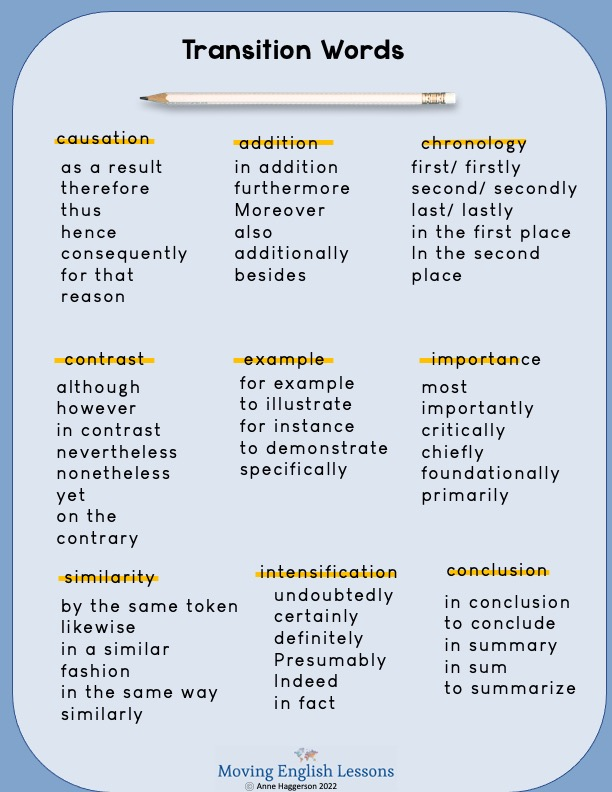
Also worth mentioning is that the IELTS rubric touches on the idea of making the ideas flow and connect in a natural way that attracts no attention. The idea of attracting no attention seems very strange and odd to me since, many times, as writers we want to lead the readers and signpost what is coming next, clearly signaling the flow from one topic sentence to the supporting details.
So, I’m not sure why the idea of making every transition so subtle is a point that exists in the IELTS rubric, but maybe they want to emphasize the idea of natural flow without any awkward jumps from one idea to the next.
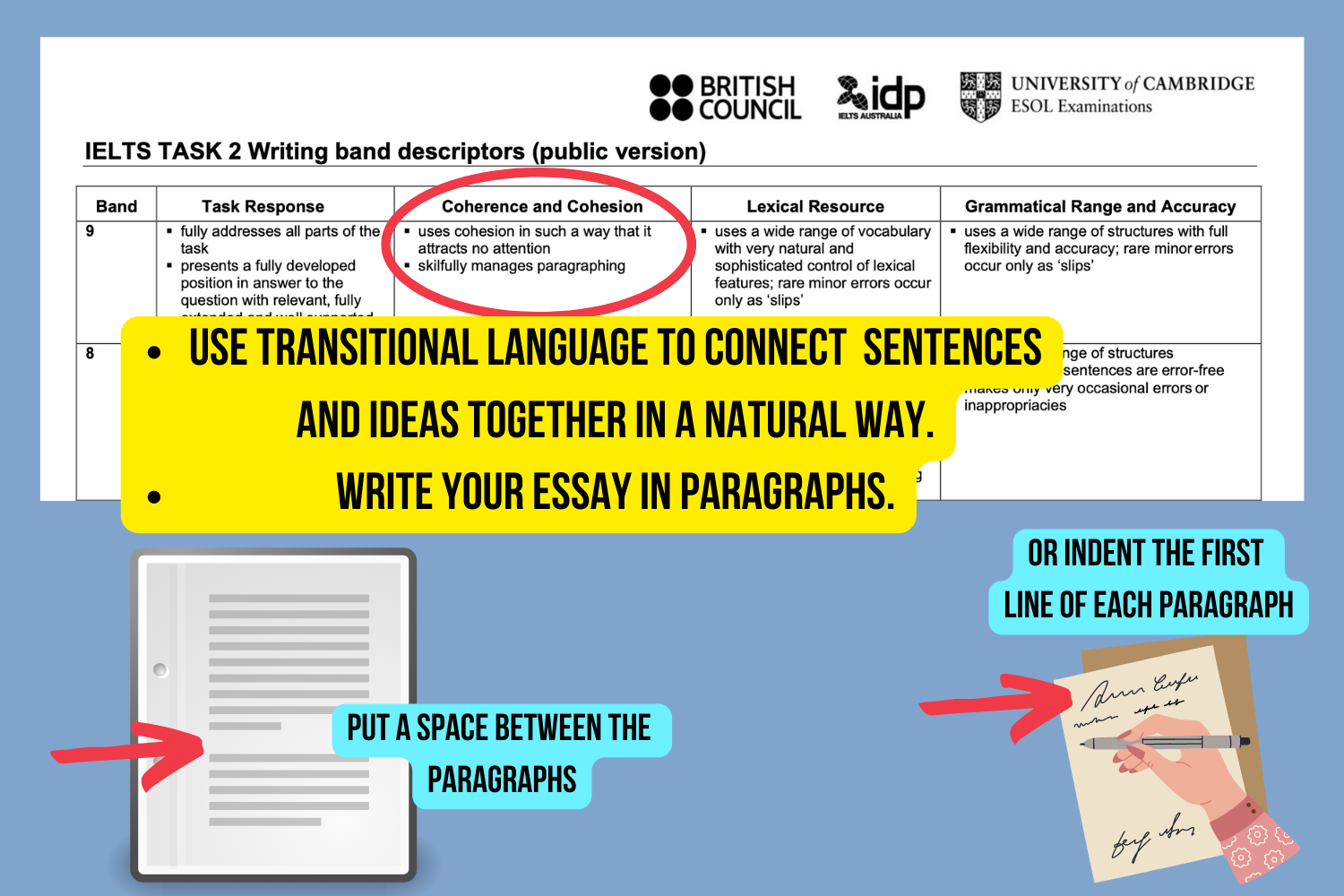
4. Syntactic Variety and Grammatical RangeÂ
The TOEFL rubric states that syntactic variety is rewarded. What this is really getting at is the idea of varying sentences between simple, complex, and compound structures. You can read more about this strategy in a previous blog post, where I go into detail about sentence structure.
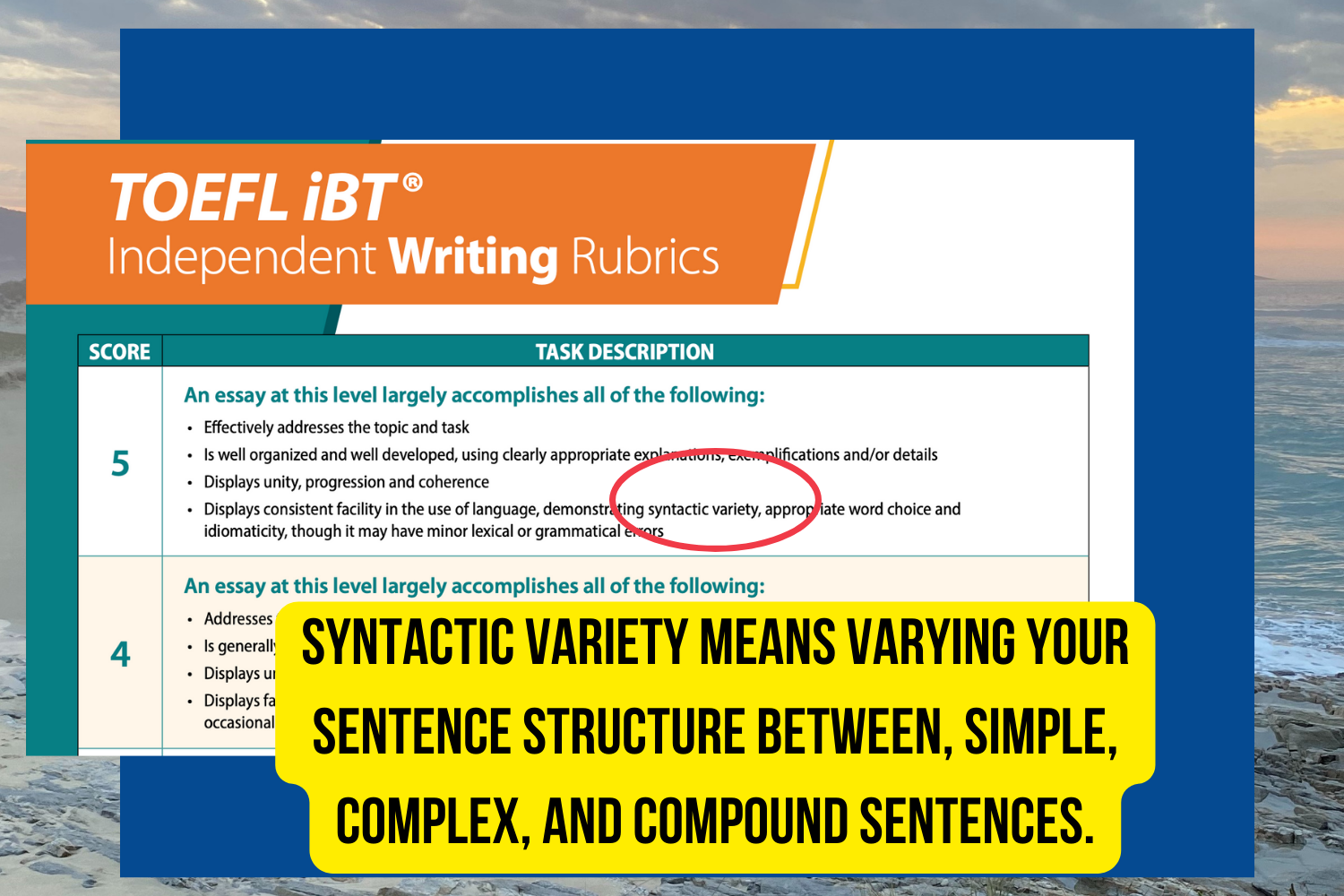
By analyzing sample TOEFL essays, it can be helpful to highlight model sentences and read high scoring answers to see what good writing looks like and make note of that to inspire future essays that we write. As you can see, in the following sample essay I wrote about well-mannered children, I highlighted certain transitional words.
These model sentences can help students discover how to structure their own sentences and how to begin sentences in unique ways. I might use a resource like this with students to help them learn how to vary their sentence structure.
If you consider an inquiry-based pedagogical model, where students discover these writing techniques by asking an essential question, then the student becomes more autonomous in the learning process. An example of an essential question to drive the inquiry process might be: How might I write sentences that aren’t all the same?
One great activity to do with your students is to go through sample essays and highlight the kinds of phrases and sentence structure that are being employed. This kind of analysis work can be very motivating and illuminating for students to see the kind of options they have. Â It can also help them move through writer’s block. You can find sample TOEFL essay questions and model essays on TOEFL resources, on the ETS website, on the TST prep website, and on MAGOOSH.
Admittedly, students can practice writing their TOEFL essays using a free tool that was developed by ETS called Edagree and has useful tools that track the word count, transitional language, and grammar. Michael Goodine has a very complete Edagree tutorial on his website and explains how to use the software in more detail.
Recently, I worked with Lorenzo on TOEFL writing task two over a period of one year.I graded his essays based on the rubric. Then, I could compare his essays and improvements over time and keep a kind of portfolio of student work as a form of documentation. You could do the same by keeping speaking samples.

In a recent article, Douglas Hamano-Bunce (2022) discusses the positive impact looking at model essays has on students’ work.He reported in his small study that students writing became more complex with exposure to model texts.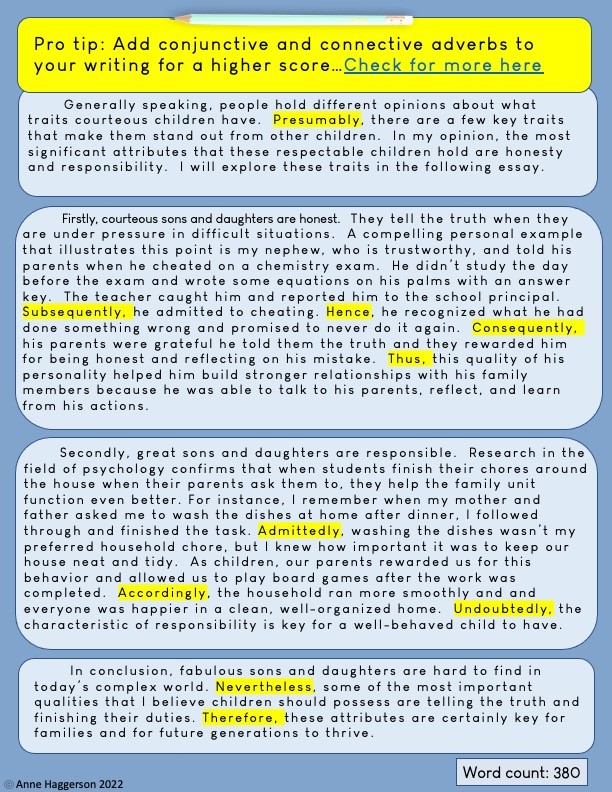
A sample TOEFL essay from my TOEFL Writing Template
The IELTS essay rubric emphasizes the use of a wide range of structures.According to the IELTS expert, Veena Krishnamurthy, this means, being able to display flexibility in writing, choice of a variety of sentence structures (to not show range, but also to avoid repetition) – clauses, conditionals, simple/compound/complex sentences, use of gerunds…, tenses as required (not sticking to just one tense all the time) and all this without compromising on the intelligibility.
From Veena’s comment, we might infer that the level of writing on the IELTS that is required to get a band score of 8+ is much more nuanced and eloquent than what is required to get a 30 on a TOEFL essay. If you compare TOEFL essays that score 5 on the rubric across the board with IELTS essays that have a band 9 score, the IELTS essay demands a very complex linguistic repertoire in comparison.
Despite the differences in language required on the IELTS essay, some IELTS experts point out that there may be some discrepancies in grading the essays since the essays are graded by trained and certified IELTS examiners rather than by machines. The TOEFL essays are graded by e-raters primarily, so perhaps there is more consistency because of that. Find out more about how the TOEFL essays are evaluated here.
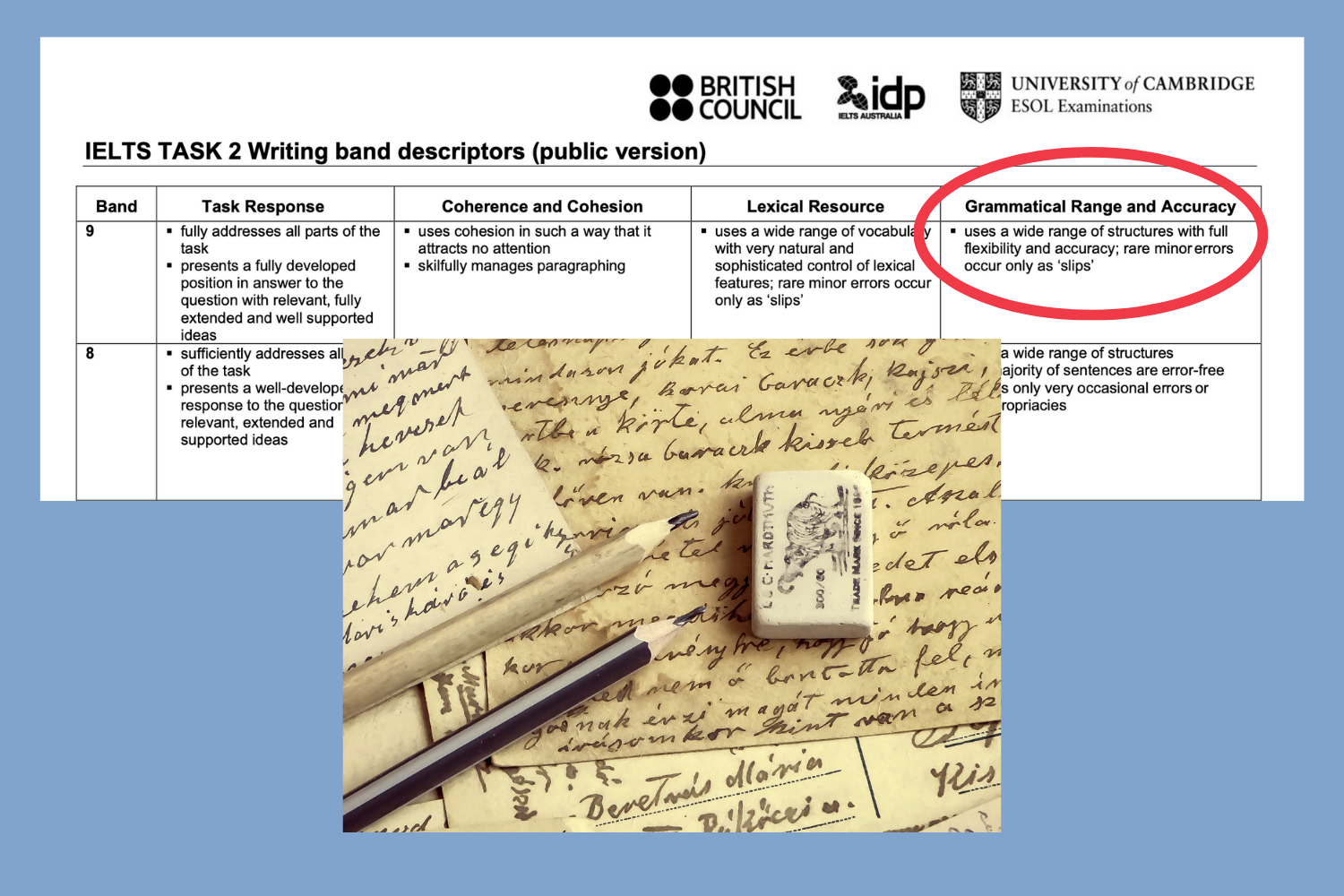 Â
Â
Mark Feely, an ELT materials writer and IELTS expert, gives us the following sample IELTS texts that he wrote to analyze and compare:
Here is a sample IELTS essay question:
These days, there is a growing trend around the world for families to have a small family.What are the advantages and disadvantages of having a small family rather than a large family?
Lower Band Model Response
First of all, there are some disadvantages of having small families. One disadvantage is that children have to look after their parents when they get older. In many developed countries, the population is getting older. As a result, families are becoming smaller and there are fewer children to look after parents. Therefore, children from small families have to take care of their parents by themselves. In larger families however, the time and cost can be shared between family members. Consequently, there are some disadvantages of having a smaller family.
Higher Band Model Response
In the first instance, smaller families can be disadvantageous for a smorgasbord of reasons. One of these is the burden of responsibility of looking after ageing parents. Many developed countries are experiencing a declining birth rate, resulting in there being fewer children to share familial duties. Although, in the past, these obligations could be shared between siblings, nowadays, this isn’t always possible, especially in the case of an only child. Being raised as part of a larger family can consequently, be more beneficial.
- With your students, you could go through the above samples and compare the grammar, sentence structure, and vocabulary and highlight the key differences.
If you are looking for sample IELTS essays to review with your students, consider this blog post by Fiona where she explains how to write a band 9 IELTS essay and shares a model essay. Additional sample IELTS essays can be found on this motivating IELTS podcast website. Also, IELTS with Liz has many helpful tips and essay samples.
Also, a wonderful tool that both teachers and students find to be helpful from Cambridge English is Write & Improve, which also encourages students to write daily and gives them automated feedback.
In addition, IELTS expert, Pauline Cullen has a plethora of excellent activities to do with your students and a useful IELTS writing coursebook for students.
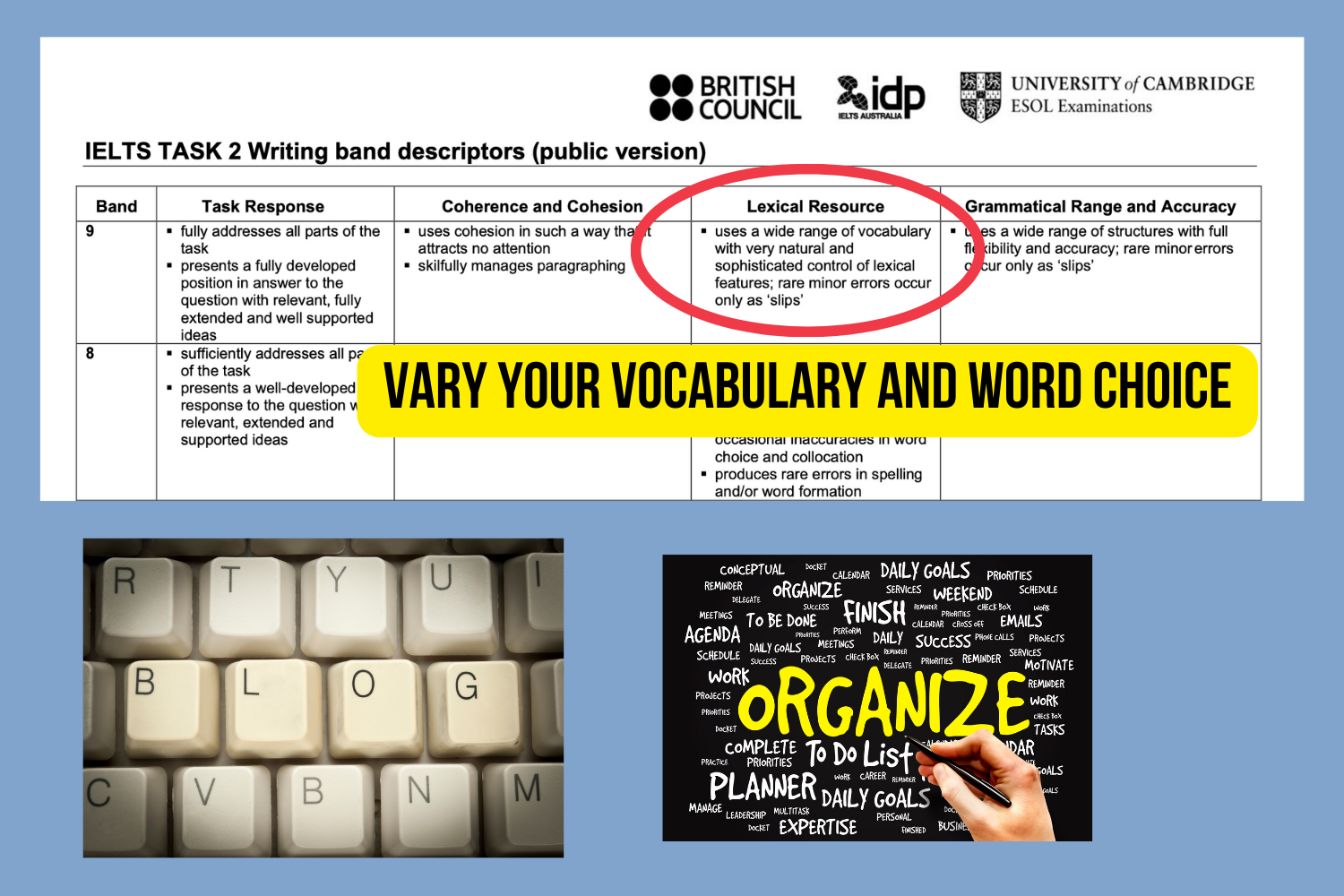
5. Vocabulary and Corpus Linguistics
Both the TOEFL and the IELTS rubrics note the importance of word choice. The IELTS rubric refers to using rich vocabulary under the lexical resource heading, whereas the TOEFL rubric defines this as word choice and idiomaticity, which essentially means using collocations and words and expressions that naturally fit together and that are commonly used in contemporary English.
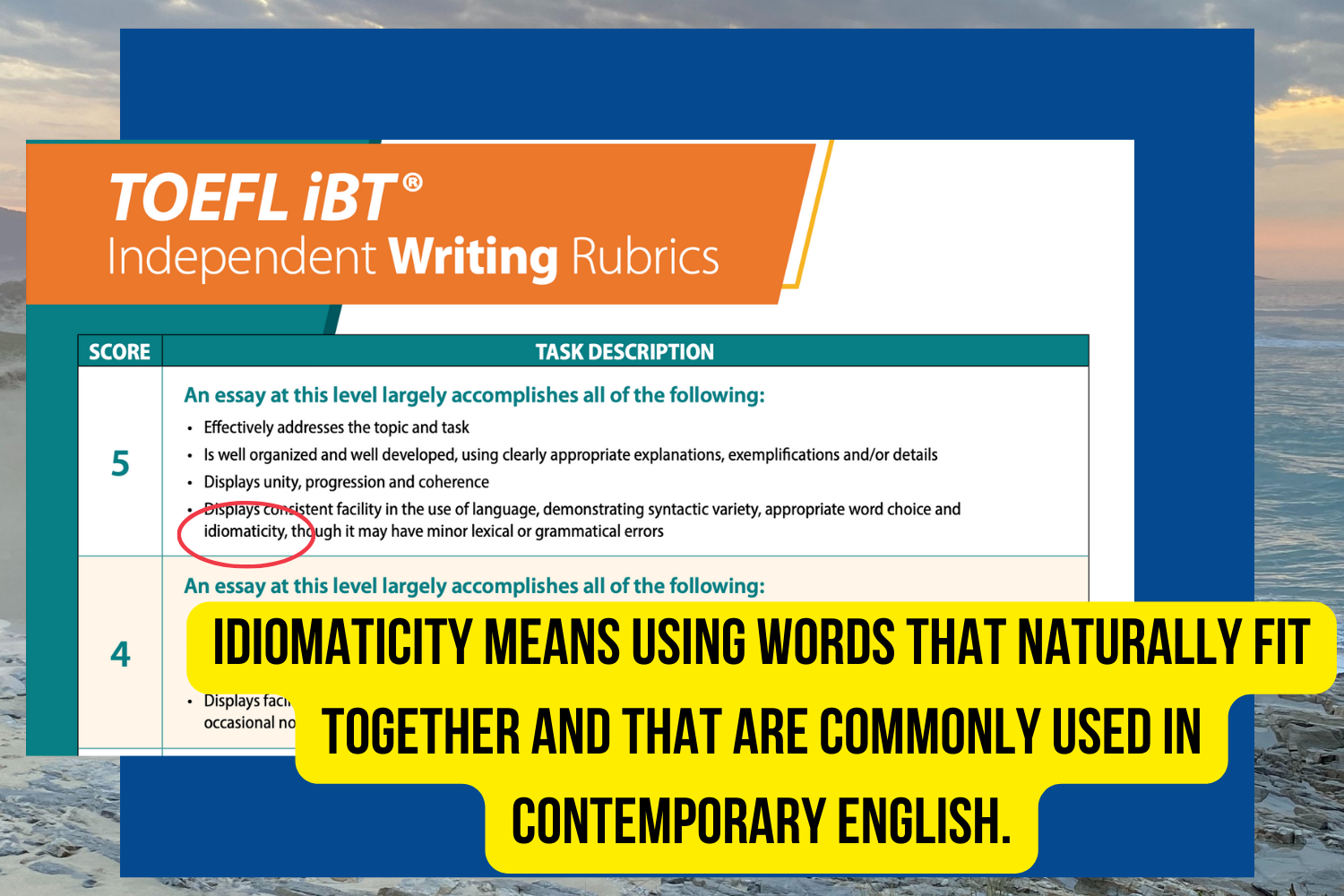
Students can use idioms like over the moon,but idiomaticity doesn’t necessarily translate literally into students using idioms in their writing.Rather, it alludes to the idea of using natural combinations of words that are commonly used in contemporary English. I bring up this point because students may waste time thinking of the perfect idioms for their TOEFL essay, which may get in the way of them prioritizing other important points in their essays.
You may be wondering how you can work on helping your students build their vocabulary and have enough tools in their toolboxes to be successful on exam day. One great resources, that is typically overlooked by teachers, that you can help your students navigate is Corpus Linguistics websites that are free and powerful.
Search for a word like attention and you will get information about how to pronounce the word, synonyms, collocations, and example sentences.
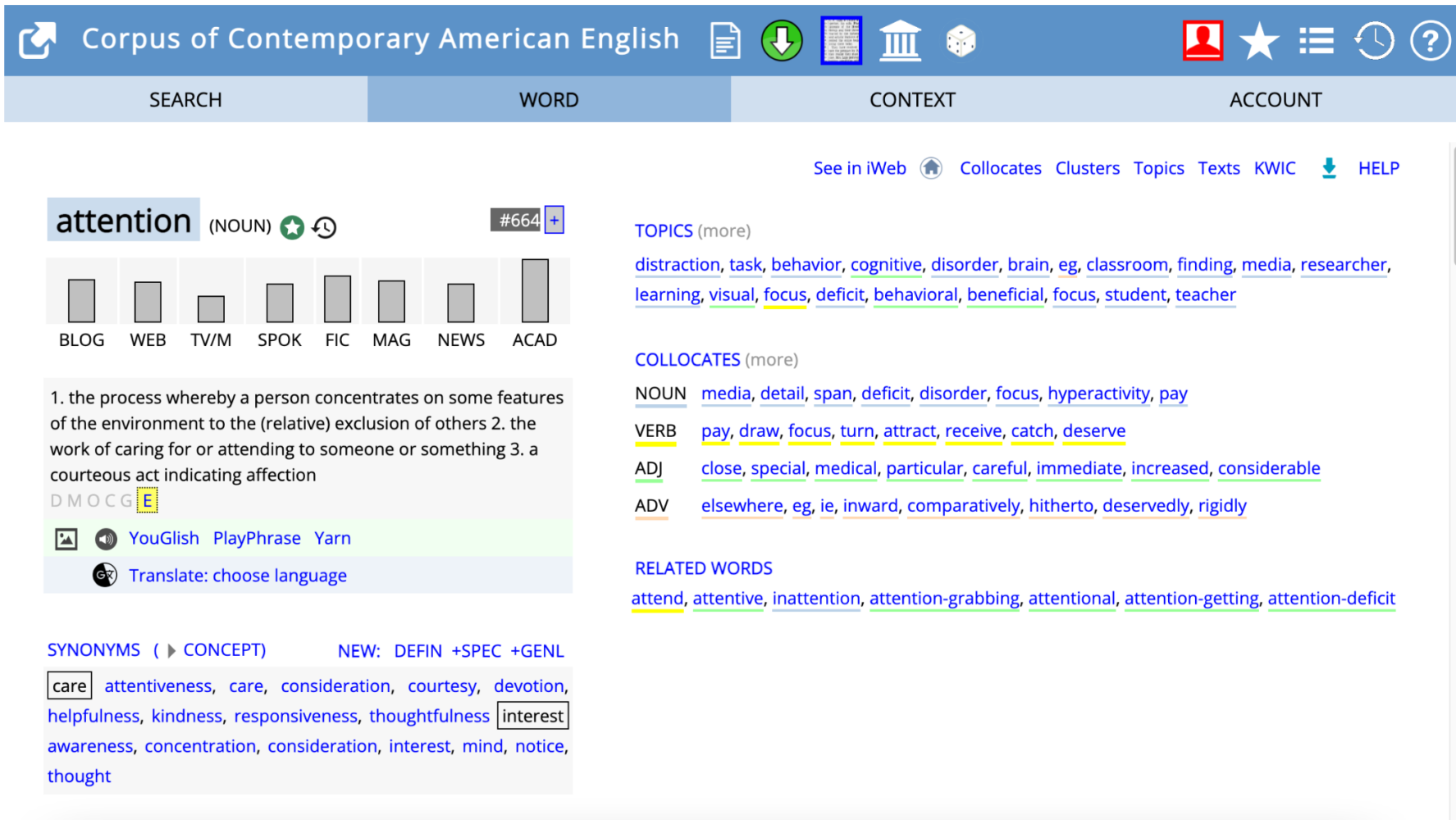
There is a learning curve to use this software, so it might be useful to do a YouTube tutorial to learn how to register on the site and use it with ease. The Corpus Linguistics is a tool that your students will undoubtedly find invaluable in the process of academic writing and taking their essays through the writing process.
In conclusion, there are many similarities between the TOEFL and the IELTS essay rubrics, including the way they are organized and the more advanced vocabulary required in them. However, in the area of grammatical structures that are encouraged, the IELTS essay demands more of students. Nevertheless, I hope this article has provided some insight into how teachers might encourage their students to decode the rubrics and use them to write a high-scoring essay.
What is your experience with the TOEFL and IELTS independent essay rubrics? Please comment below and tell us how you have used the rubrics and made them more accessible to students throughout the learning process.






